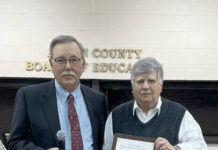
The BOE met to address the teacher shortage and teacher retention problems, particularly in the sixth grade as discussed with the research study here.
Hannah Barron | Anson Record
School board considers strategies to address issue
WADESBORO — The Anson County Board of Education held a special meeting on Monday, November 8, to address problems in the district, particularly the statewide teacher shortage.
North Carolina teachers are quitting in “staggering numbers,” a Charlotte-Mecklenburg Schools official told WFAE, and substitutes have been in low supply. Throughout the region, bus drivers have been hard to come by as well.
The majority of the shortages are happening in rural counties like Anson, making it now a countywide concern. According to the North Carolina Department of Public Instruction, Anson had a 12.4% teacher vacancy rate in 2019-20 ranking it among the five worst counties in teacher vacancy rate. A board member said during the meeting that Anson County has lost 11 teachers this year and expects to lose more at the end of the year from retirement.
Superintendent Howard McLean proposed strategies to correct this trend to the board including taking steps to retain staff, recruitment of new staff, improving success rates for transition in key grades (kindergarten, sixth, and ninth), identifying research and grant opportunities, employing continuum of instructional strategies such as using instructional coaches as necessary, and contracting service providers from other countries to replace teacher vacancies as they’ve done in previous years.
McLean noted many of these have pros and cons, and need further research. The Board decided to focus on the most pressing and immediate concerns with the teacher shortage and retaining teachers and focus on the others in the long term.
The Board is considering options to fill vacant positions such as the district’s certified teachers not already in teaching or office positions, long-term subs, volunteers from the community for supervision duties, and auxiliary staff. They spoke with 40 December graduates last week and made some offers that haven’t been accepted yet, as well as shared openings with North Carolina universities. They have also partnered with the University of North Carolina-Pembroke to give students field experience by placing them in district residency jobs or student-teacher positions.
Suggestions for recruiting included incentives and sign-on bonuses. Anson is also a poor district low on money, up against districts with more competitive benefits. Board Attorney Michael Flake noted the school district is in a seller’s market with the most lucrative buyers getting the best pickings, and Anson hasn’t been quick enough with the dividends.
“Statewide demand far outweighs the supply at this time,” Flake said.
They are considering incentives and funding to boost the human resources department, but they need to find a funding source. The Board of Education does have $3 million in its reserve balance but they must use that wisely because it is meant to be used for major problems, and won’t stretch very far between all eight schools.
“Why aren’t we celebrating faculty and staff already? … It shouldn’t need to be a recommendation to the board. It should just be done,” said District 4 Member Lisa Davis about incentives and the current shortage. “People come for the money but stay for the relationships with the people they work with, and if that is broken down, no amount of money fixes it in the long-term. Throwing money at it isn’t the fix. Addressing the issue is the fix.”
Davis sees the issue as teachers not feeling supported by their administration; that teachers are not receiving help, are working an unfair amount, and are not being heard.
McLean noted there is no way of knowing why teachers contemplate leaving, but said he has had four teachers talk with him prior who have continued to stay on. They also have a School Improvement Team at each school to listen to teachers’ problems. McLean suggested visiting each school himself to let teachers know they have a voice through their SITs. He will also seek funding sources to help support the district.
Other board members echoed Davis’s statements, saying that while principals are already doing the best they can in the given conditions to show their faculty and staff that they’re valued, an incentive could simply mean showing appreciation for their work. Their teachers have worked through a pandemic, adapting their day-to-day jobs and putting in odd hours to give students the best education possible. Many are now being called to teach other positions during the shortage and are losing crucial planning time.
“It goes a long way to thank someone for being there,” said Board Member George Truman.
What to do with the sixth graders?
Another issue discussed is the decision on whether to move sixth-graders back to their home elementary school or keep them at the middle school. Sixth grade currently has the most teacher vacancies.
McLean had his leadership team conduct a research study on whether a K-6 or 6-8 model is better. The data can be used to guide decisions about moving teachers, what configurations can work best, determine if there are even greater problems, and whether the move is even doable. However, the study is based on research alone, not on the school system’s first-hand experience. The data mostly does not reflect the conditions of the pandemic and taken from a mix of public schools with different variables, so it could be like comparing apples to oranges.
The team compared curriculum models as an unbiased group with six principals over two days.
They found that the 6-8 model had an interdisciplinary, family approach with collaborative time for planning. Curriculum and resources are also housed together. Disciplinary infractions are also much lower in the 6-8 model. However, when housed in the middle school, the students lose ground in reading and math. Growth and proficiency is also higher in the K-6 model, according to the last consistent test data in 2018-19.
For the 6-8 model to work, the key is effective transitioning, created from a good school climate and culture. The school must be a great place to be, conducive for learning.
“School grade span doesn’t determine success but school climate and culture does. If the climate and culture are strong, learning will take place and good things will happen — that’s what the research tells us,” said the team spokesperson.
Several of the Board noted that parents would be unhappy if students are returned to their elementary school, and it could also negatively impact the teachers and psychologically the students who have already lost a grade of learning due to the pandemic. They also said it would be a hassle to reconstitute the 232 students, and even after the move, they could still be short on teachers. It could also be too big of a change too soon.
Currently, there are little discipline issues within the sixth grade, with most discipline happening at the seventh grade and little interaction happening between the grades. Students are currently completing a PRIDE survey in their ELA classes and so far they have had 230 responses. Not all were sixth graders, but 88% said they feel safe most or all the time at school. They also have a 98% mediation rate between students for bullying and other interpersonal conflicts.
The middle school also implemented “restorative practices” for new discipline strategies on Monday which included a rebranding of ISS, stopping repetitive behaviors and repetitive trips to ISS, noting trends of frequent behaviors, and decreasing response time from the administration. They are working on any problems and training feedback with teachers, with the expectation of good results and key learning “experience on the fly” for teachers, said Anson Middle School Principal Darrell Potts.
At this time, they are recommending waiting on the decision until the end of the year so they consider students’ and parents’ wishes, and further study the data. For now, students will remain at the middle school with long-term subs and certified teachers being added to vacant spots. The Board will also monitor the new discipline plan weekly to see if it solves the problems or if there needs to be any tweaks or revamping. Monitoring updates are planned for the regularly scheduled Board meeting at the end of November.
For further information on the shortage and retention, contact the Board Clerk, Administrative Assistant to the Superintendent, and Public Information Officer Anne Trexler Hyatt at 704-694-4417 extension 1903 or hyatt.anne@anson.k12.nc.us.
To support the Anson Record call 704-994-5474 or visit https://ansonrecord.com/subscribe.
Reach Hannah Barron at 910-817-2668 or hbarron@ansonrecord.com.




